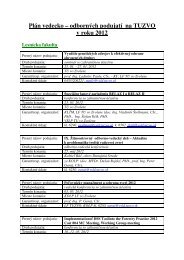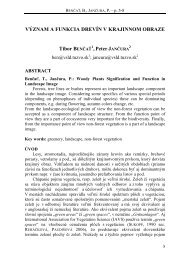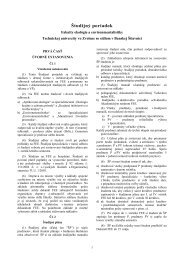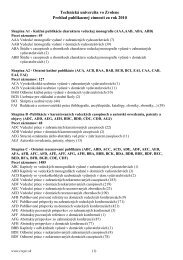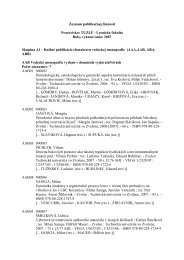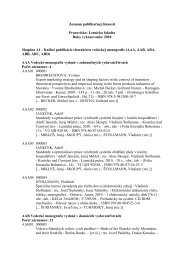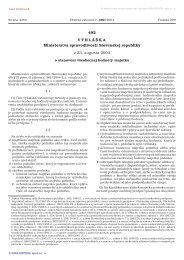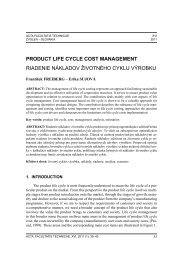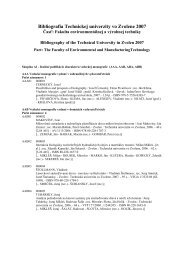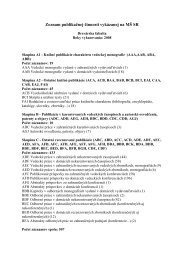Acta Facultatis Ecologiae - Technická univerzita vo Zvolene
Acta Facultatis Ecologiae - Technická univerzita vo Zvolene
Acta Facultatis Ecologiae - Technická univerzita vo Zvolene
- No tags were found...
Create successful ePaper yourself
Turn your PDF publications into a flip-book with our unique Google optimized e-Paper software.
81was not confirmed. Maximum of mercury concentrationwas detected in the leaves of birch. Proportionof total mercury contents in the soil to assimilatedmercury in the biota was the highest in thebirch sample from Hnilčík – Winter Valley and wasthree times higher.CONCLUSIONThe one-shot sequential extraction that characterizedindividual forms of mercury bonds in thesoil was used for determination of mercury mobilityin the contaminated soils from the Rudňany area.Tab. 3 Comparison of mercury content specified in biota: birch, cedar, spruce and soil from Rudňany areaNo.LocalityBirch[ng.g –1 ]Spruce[ng.g –1 ]Cedar[ng.g –1 ]Total content of Hgin the soil [ng.g –1 ]1 Štefanská Huta 161 119 230 122 4402 Kolinovce 72 105 51 3 7003 Matejovce 37 136 65 7 1604 Poráč 68 110 84 116 5005 Rudňany – Winter Valley 271 63 31 48 6006 Rudňany – opposite to manufactory 370 216 27 80 6207 Rudňany – sludge bed – 124 124 11 8108 Hnilčík – Winter Valley 380 52 38 1 195On the basis of the results we can state that mercuryis not bonded in the form bio-accessible forplants, but it remains fixed on crystal lattice and instructure of mineral matrix. This conclusion is consistentwith results reached by Závadská et al. [1].Correlation relationship between the total mercurycontent in the soil compared to that in biota wasmonitored in this locality but it was not confirmed.The mercury from the anthropogenic human activity(like the Rudňany area) is in such environmentsuperimposed to its geochemical background,while high concentration of mercury in the localscale may arise with its dangerous impacts on theenvironment.AcknowledgementsThis work was supported by the Slovak Researchand Development Agency, No 20-027705 andby the Slovak Grant Agency for Science VEGA(grant No-2-5149-26).REFERENCES1. ZÁVADSKÁ, M., ŽEMBERYOVÁ, M., FARKA-ŠOVSKÁ, I.: Speciation mercury in soils using sequentialextraction, Chem. papers 93, 391–393, 19992. McLAREN, R. G., CRAWFORD, D. V.: Soil Sci.24., 172 19733. TESSIER, A., CAMPBELL, P. G. C, BISSON, M.:Anal. Chem. 57, 844, 19794. VOJTEKOVÁ, V., KRAKOVSKÁ, E.: Fractionationanalysis in dust sediments, limitation selectivity sequentialleaching, Chem. papers 100, 1096–1104,20065. URE, A. M., DAVIDSON, C. M., THOMAS, R. P.:Single and seguential extraction schemes for tracemetal speciation in soil and sediments, Quality Assurancefor Environmental Analysis, Elsevier ScienceB. V. ch. 20, 505–523, 19956. SZABOVÁ, T., ZAHURANEC, E., KOŠČOVÁ, M.,Influence application zeolit on <strong>vo</strong>lume heav metalin soils and bio-accessible forms, In:Agrochemical4/2005, 19–227. Supplement no.2 of law no. 220/2004 S.c.8. TUREK, M., KOROLEWICZ, CIBA, J.: Removalof heavy metals from sewage sludge used as soil fertilizerIn: Taylor&Francis, 2005.ISSN 1532–0383



